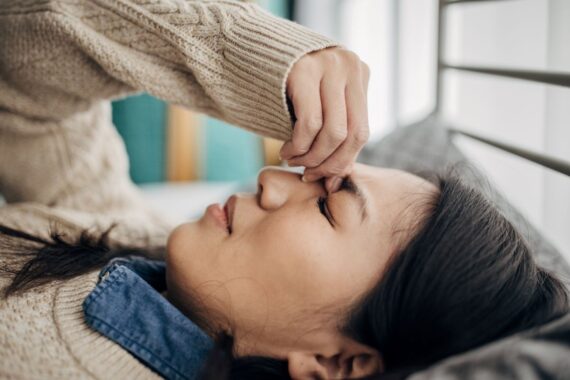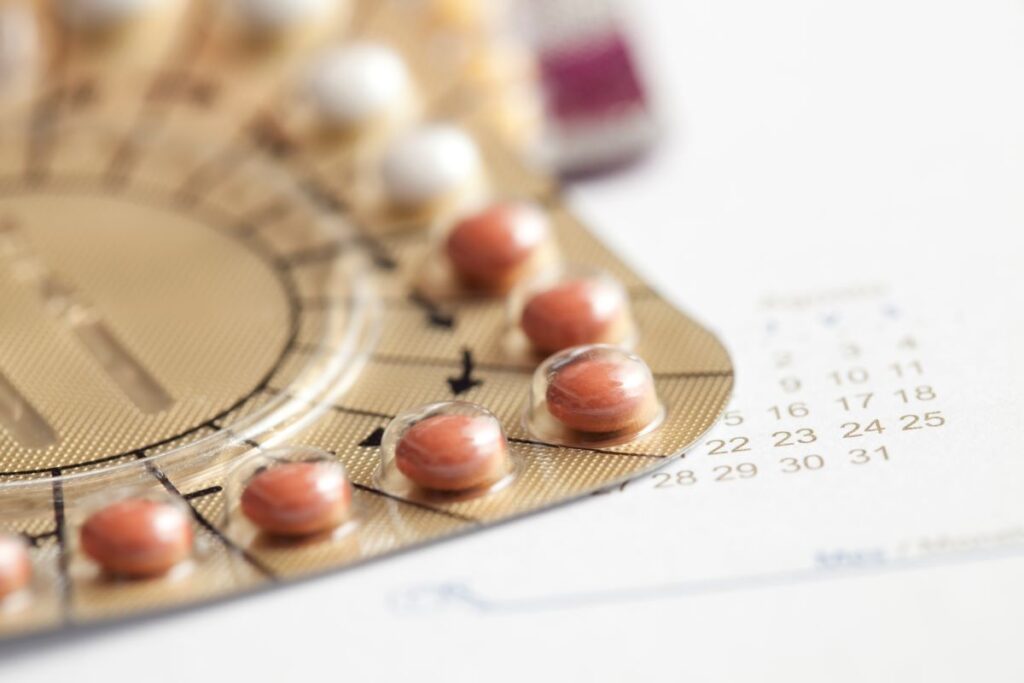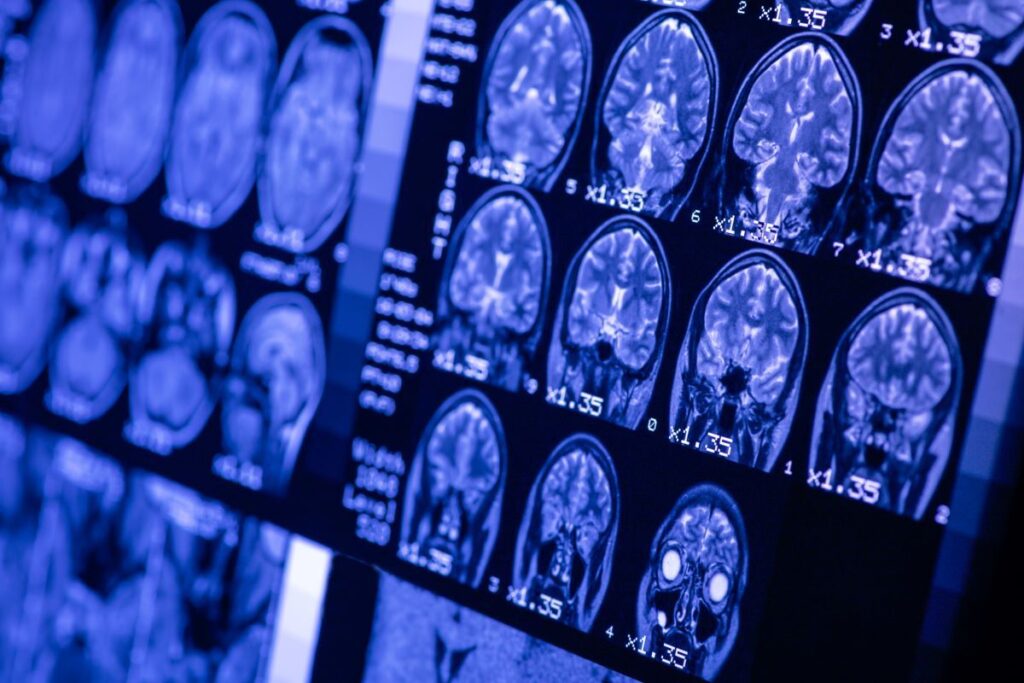Migraine: Myths and Facts

In the first of a new series exploring some common misconceptions about conditions seen in general practice, GP and headache specialist Dr Richard Wood debunks some myths about migraine – and explains some perhaps less well known facts
Myths
1. Chocolate and caffeine are common dietary triggers and should be avoided by migraine sufferers
While some foods can sometimes be a trigger for migraine, this is not the case for all migraine sufferers, and the identification of specific food triggers has not yet been robustly demonstrated in research.1 The problem with this myth is that patients struggling with migraines routinely exclude often-quoted triggers (such as cheese or chocolate) – denying themselves the little pleasures in life potentially unnecessarily. In reality, many migraineurs have no problems with them. In clinical practice food triggers are usually obvious to the patient and needs no research to validate it (‘if it’s a trigger for you, then it’s a trigger for you’). Where food is a trigger, it is probably through triggering inflammation. Hunger and dehydration are more likely to be triggers than specific foods. Falling caffeine levels (rather than caffeine per se) is another. An alternative school of thought around food triggers recognises that migraine often has a prodrome phase in the 24 hours before a migraine where cravings can occur. A migraine sufferer might start craving chocolate in their prodrome phase, eat it, then the migraine develops. They assume chocolate was the trigger, when actually it was the omen.
2. You need a headache to diagnose migraine
You can have migraine phenomenon without a headache. A lack of awareness of this can prevent a clinician making a diagnosis of migraine, under-treating and/or over-escalating, which can cause anxiety for both patient and doctor. Two common examples are:
- Acephalgic migraine. Here, the patient suffers features of migraine aura (such as visual disturbance, migrating paraesthesia, or difficulty word finding) for between 3 and 60 minutes, but without any associated headache. They may have some other migraine features such as sensitivity to light and sound, or mild nausea. Migraine auras without headache are actually harder to treat acutely than migraine headache but can respond to 900mg dissolvable aspirin. The frequency can be reduced by using a preventer.
- Retinal migraine: This is typically a migraine headache associated with aura of the retina (a monocular visual disturbance, rather than a visual field disturbance). Though this can occur around a migraine headache, it can just as easily occur without.
3. All female patients with migraine should avoid the combined hormonal contraceptive pill and HRT
Only patients with a history of migraine with aura (MA) should avoid the combined hormonal contraceptive (CHC). This is because MA is associated with particularly high levels of inflammation in the blood vessels in the meninges and inflammation increases the propensity for thrombus formation (see Facts below). Oestrogen itself also makes blood sticky. The combination of CHC and MA may be associated with a 6-fold increased risk of stroke.2 Whilst inflammatory processes also occur in migraine without aura (M0), it is to a lesser extent, and the risk of an ischaemic stroke is much lower. So, CHC in M0 is acceptable in many circumstances (see the UKMEC criteria for detail).

Females with a history of MA can still take oestrogen-containing HRT. This is because the oestrogen in HRT tends to be at a much lower strength than in contraception. However, in the abundance of caution, specialists advise these patents take HRT in a topical form rather than oral – such as patches or gels.
4. A migraine preventer should stop all migraines
Sadly, this is not something we can achieve yet. Migraine is a genetic disorder, and your patient will always be vulnerable to them. Headache specialists increasingly see migraine sufferers’ headache machinery as just more ‘sensitive’ than those who do not suffer migraines and therefore easier to turn on. One way to conceptualise preventers is to describe them as making the migraine machinery less sensitive, so it does not turn on all the time with the various triggers that might do it, but there will occasionally be a trigger which pushes them over the edge into a migraine. Preventers take 8 weeks to work once you are on a therapeutic dose, and they should halve how many headache days a patient has and how bad they are. If working, a course is as long as the patient likes, but we normally say a further 3-6 months before having a ‘drug holiday’ (the efficacy of preventers tends to wear off when taken long-term).
5. Migraine worsened by Valsalva or on-setting at night is a red flag
These are common reasons for avoidable referrals. Referrers frequently confuse some of the ‘red flags’ of headache with common features of migraine. For example, a cardinal diagnostic feature of migraine is ‘aggravation by routine physical activity’: everything hurts when you have a migraine, including those movements which would not normally be painful outside of a migraine – such as coughing, straining or bending forward. This is very different from where Valsalva triggers a headache (that is, the patient does not have a headache, then coughs, then the headache immediately starts) – which needs more investigation.
Similarly, migraine likes to turn on at night or in the morning. This is not to be confused with a high-pressure headache, which will also be evident in the night/morning when the patient is lying supine. For pressure headaches, look for a reliable trigger from changes in posture (lying versus standing), rather than simply ‘starts at night or in the morning’. Is there any papilloedema to suggest raised intracranial pressure; is there anything in the history or examination to suggest they may be vulnerable to CSF leak causing low pressure (such as labour in the recently pregnant, or severe neck osteoarthritis where osteophytes can ‘nick’ the c-spine dura).
Facts
1. If a patient has episodic disruptive headaches with a normal neurological exam and blood pressure, assume its migraine until proven otherwise
Headache is mentioned in one in 10 GP consultations and is the reason for attendance in one in 25 consultations (two per day for the average GP). One large US-based primary care study identified that, after excluding those with secondary headache disorders, chronic headache, or rare established migraine subtype diagnoses, 94% of all headache presentations were migraine (76%) or probably migraine (18%).3 A further 3% were tension-type headache – which, in effect, we treat similarly as we do migraine, recognising that they are likely to be on a spectrum. Thus, around 97% could be managed as migraine. The question then is, what percentage of the excluded presentations end up being migraine? This answer is harder to come by because you have to make inferences across different studies and populations. A UK study in primary care identified that 6% of new headache presentations were labelled by primary care clinicians as secondary headaches,4 but 85% of those were ‘sinus headache’, and we know from yet other studies that 88% of those are likely to be migraine (see below).5

Anecdotally, a significant proportion of headaches referred to rapid access neurology clinics end up with a diagnosis of migraine. So, while the numbers are not definitive, headache specialists work to the maxim that in a primary care setting, a patient who presents with a stable pattern of episodic headache with a normal neurological examination and blood pressure should be assumed to have migraine until evidence presents to the contrary. That way, we will manage more headache more effectively.
2. Dizziness is a common feature of migraine
The presence of dizziness with migraine can often make a clinician feel unnecessarily uneasy. Around 40% of migraine sufferers (with or without aura) will report dizziness. This may be vertigo (the room spinning around you) or an inner sense of unsteadiness (as if on a boat). Dizziness is simply another non-pain symptom of migraine. Episodes can lasts seconds, minutes, hours or even days.
In one form of migraine – vestibular migraine – the dizziness is the dominant presentation, and can occur without migraine headache up to 50% of the time. We treat vestibular migraine in the same way we do other migraines – it may respond to a triptan or 900mg of dissolvable aspirin, and preventers should be offered if it is frequent enough to be disruptive.
3. Many of the recurrent sinusitis presentations you see could in fact be migraine
Migraine is an inflammatory disorder – there is aseptic inflammation going on and it is the inflammatory molecules which trigger pain. Usually, this occurs in the meninges (where most headache is felt). But it can just as easily occur on the maxillary sinuses. This gives the patient (and the clinician) an impression of a sinusitis, especially as accompanying congestion is usual. But it is neurologically mediated – rather than by a virus, bacteria or allergen. In fact, one primary care study estimated that 88% of patients describing a ‘sinus headache’ had migraine or probable migraine.5 You’ve probably seen this presentation more often than you realise: the patient who attends saying ‘I’ve got my sinusitis back, but if you give me my antibiotics it will be gone in 3 days’. Do they have a fever (leans away from migraine)? Do they have a headache elsewhere on the head (leans towards migraine)? Are there any other migrainous features (sensory sensitivity or nausea)? Consider a triptan and NSAID next time, where appropriate for the patient.
4. Patients shouldn’t take analgesia (including triptans) on more than two days per week
This is likely to be a phenomenon which affects migraine sufferers specifically: if they take paracetamol or an NSAID on 15 or more days per month, or a triptan (or, worse yet, opioids such as codeine) on 10 or more days per month, for three months in a row, they can lock their migraine centres on. This often presents as migraines of increasing frequency, often with a grumbling headache in between which never seems to go away. It renders the headache disorder much less response to active and preventer therapy. The most effective treatment is a wash-out of all analgesia or triptans for 8 weeks – very hard for the patient, who will suffer a lot during this time (especially if they are on opioids). But 75% of those who do this revert to less frequent migraines which are easier to treat.
5. Migraine with aura is associated with an increased risk of stroke
This is because migraine is an inflammatory disorder, and inflammation increases the risk of cardiovascular events. Indeed, QRISK3 includes migraine with aura as a risk factor in its calculations. However, though the relative risk of stroke in the context of migraine with aura is notable, the absolute risk is still small. For example, if you take 10,000 women aged >45 years, there were four extra cases of stroke in those with migraine with aura compared to everyone else.6 This is not an opportunity to scare your patient, but for opportunistic health promotion – don’t smoke, eat healthily, exercise plentifully.
Dr Richard Wood is a GPwSI in headache. He runs a headache clinic for Oxford University Hospitals NHS Foundation Trust and is Education Fellow at the National Migraine Centre
References
1. Hindiyeh NA, Zhang N, Farrar M et al. The Role of Diet and Nutrition in Migraine Triggers and Treatment: A Systematic Literature Review. Headache 2020 Jul;60(7):1300-1316
2. Champaloux S, Tepper N, Monsour M et al. Use of combined hormonal contraceptives among women with migraines and risk of ischemic stroke. Am J Obstet Gynaecol 2017 216(5):489.e1-489.e7
3. Tepper S, Dahloff C, Dowson A et al. Prevalence and diagnosis of migraine in patients consulting their physician with a complaint of headache: data from the Landmark Study. Headache 2004;44(9):856-64
4. Kernick D, Stapley S, Hamilton W. GP’s Classification of Headache: Is Primary Headache Underdiagnosed? Br J Gen Pract 2008;58(547):102-4
5. Schreiber C, Hutchinson S, Webster C et al. Prevalence of Migraine in Patients With a History of Self-reported or Physician-Diagnosed “Sinus” Headache. JAMA Intern Med 2004;164(16):1769-1772
6. Kurth T and Diener H-C. Migraine and stroke. Perspectives for stroke physicians. Stroke 2012; 43:3421-3426
Visit Pulse Reference for details on 140 symptoms, including easily searchable symptoms and categories, offering you a free platform to check symptoms and receive potential diagnoses during consultations.
Related Articles
READERS' COMMENTS [2]
Please note, only GPs are permitted to add comments to articles










We seem to be moving away from a position of there being a difference between ‘migraine’ and ‘headache’, to one where the term ‘headache’ is going to be almost redundant.
It is very interesting to think of sinusitis as a migraine manifestation : does the unilaterality aspect of Hemicrania actually still apply in sinus migraine?
Thanks David. IHS classifies headache according to phenotype – what the headache looks like. But it was primarily a research tool to minimise within-group differences. In reality, there is much overlap in the appearance of many (but not all) headaches – and especially TTH and migraine. This should not be surprising because they all arise from activation of the same cobweb of pain nerve branches of the trigeminal nerve. If you’re a “splitter”, you’ll want to separate them out based symptomatic (and other) differences. If you’re a “lumper”, you’ll have a more pragmatic heuristic based more (but not solely) on management approach.
As for sinusitis, if migraine goes to the sinuses it is literally a sinusitis (inflammation) because migraine is an inflammatory condition. It’s just neurogenic inflammation – caused by neuronal triggering of inflammatory cytokine release – rather than by any external antigen.